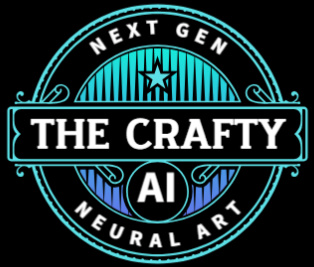www.thecraftyai.com
Using AI images for real projects - Part 5
Creating AI-generated images is exciting, but what do you do with them once they’re made? Part 5 covers all about turning your AI art into something useful, whether it’s digital content, print materials, or part of your personal or business brand. AI imagery is flexible, fast, and beautiful. When used correctly, it can save you time, boost your visual appeal, and even make you money.
Using AI-generated images for real projects has become a game-changer across creative industries, offering fast, customizable visuals for everything from marketing materials and social media content to book covers, product mockups, and web design. With the ability to generate high-quality artwork in seconds, AI tools save time and costs while empowering creators to experiment with different looks before finalizing a design. Whether you're a solo entrepreneur, a content creator, or part of a design team, AI images can enhance presentations, elevate branding, and even serve as the foundation for commercial products, provided you follow licensing terms and ensure the content aligns with your project's goals.
🔹 Where You Can Use AI Art
Use Case Examples
Social Media Instagram posts, Pinterest carousels, YouTube thumbnails
Web DesignHero banners, blog thumbnails, background images
Digital ProductsE-books, desktop wallpapers, phone lock screens, sticker sets
Print ProductsPosters, greeting cards, t-shirts, mugs, art prints
Branding/Marketing Logos (stylized), advertisements, concept mockups
Creative ProjectsBook covers, storyboards, visual novels, AI comics
🔹 Using AI Art for Digital Content
AI-generated visuals are perfect for spicing up your online presence.
Instagram & Pinterest: Use bold styles or portrait-based art to grab attention.
YouTube & TikTok: Use AI images as thumbnails, backgrounds, or even animated frames.
Websites & Blogs: Create section visuals, quote cards, or tutorial illustrations using your AI art.
Ebooks & PDFs: Give your content a visual edge with customized cover pages, chapter intros, or mood-setting backgrounds.
Pro Tip: Use platforms like Canva to combine your AI art with text and layouts for polished designs.
🔹 Using AI Art for Print Projects
Most AI art platforms can generate high-resolution images, especially if you upscale them afterward. This makes them ideal for printing.
Common Print Uses:
Posters & Wall Art
Postcards & Stationery
Tote Bags, T-shirts, and Merchandise
Calendars or Stickers
Event Flyers & Zines
✅ Make sure your image is at least 300 DPI for high-quality printing.
✅ Use tools like Upscale.Media, Gigapixel AI, or built-in upscalers on AI platforms to increase size and clarity.
🔹 Business & Commercial Use
AI imagery can give small businesses a massive visual boost—fast.
Product Mockups: Showcase your ideas before manufacturing
Ad Creatives: Make your social ads pop with fantasy, surreal, or cinematic visuals
Brand Storytelling: Use art to visually express your tone, message, or vibe
Client Work: Some designers use AI to create concept drafts for clients
🚨 Always check the platform’s license terms for commercial use.
Most major tools (Midjourney, DALL·E, Leonardo, etc.) allow commercial use if you’re on a paid plan.
🔹 Organizing Your AI Images
Once you start creating regularly, it’s easy to get overwhelmed.
Here’s how to stay organized:
Create folders by style, theme, or project
Keep a separate folder for “Print Ready” files (300 DPI or larger)
Save successful prompts in a prompt journal
Name your files with tags or version numbers (e.g., CyberFairy_v3_HD.jpg)
🔹 Bonus: Selling Your AI Art
Yes, you can sell AI-generated images (as long as you have rights from the platform).
Here are a few popular ways:
Print-on-demand shops (Redbubble, Teespring, Society6)
Etsy digital downloads (wallpapers, coloring pages, posters)
Subscription membership sites (offering new AI content each month)
Sell prompt + image bundles for other creators
AI gives you the ability to produce content fast. With the right packaging, it can turn into real income.
🔹 Final Tip: Think Like a Creator
AI art isn’t just a novelty—it’s a tool. What you create can be meaningful, professional, and profitable when used well.
Keep exploring, keep experimenting—and always ask yourself:
“Where can this image live beyond my screen?” Because when you treat your work like it matters, it will.
© 2025. All rights reserved.

